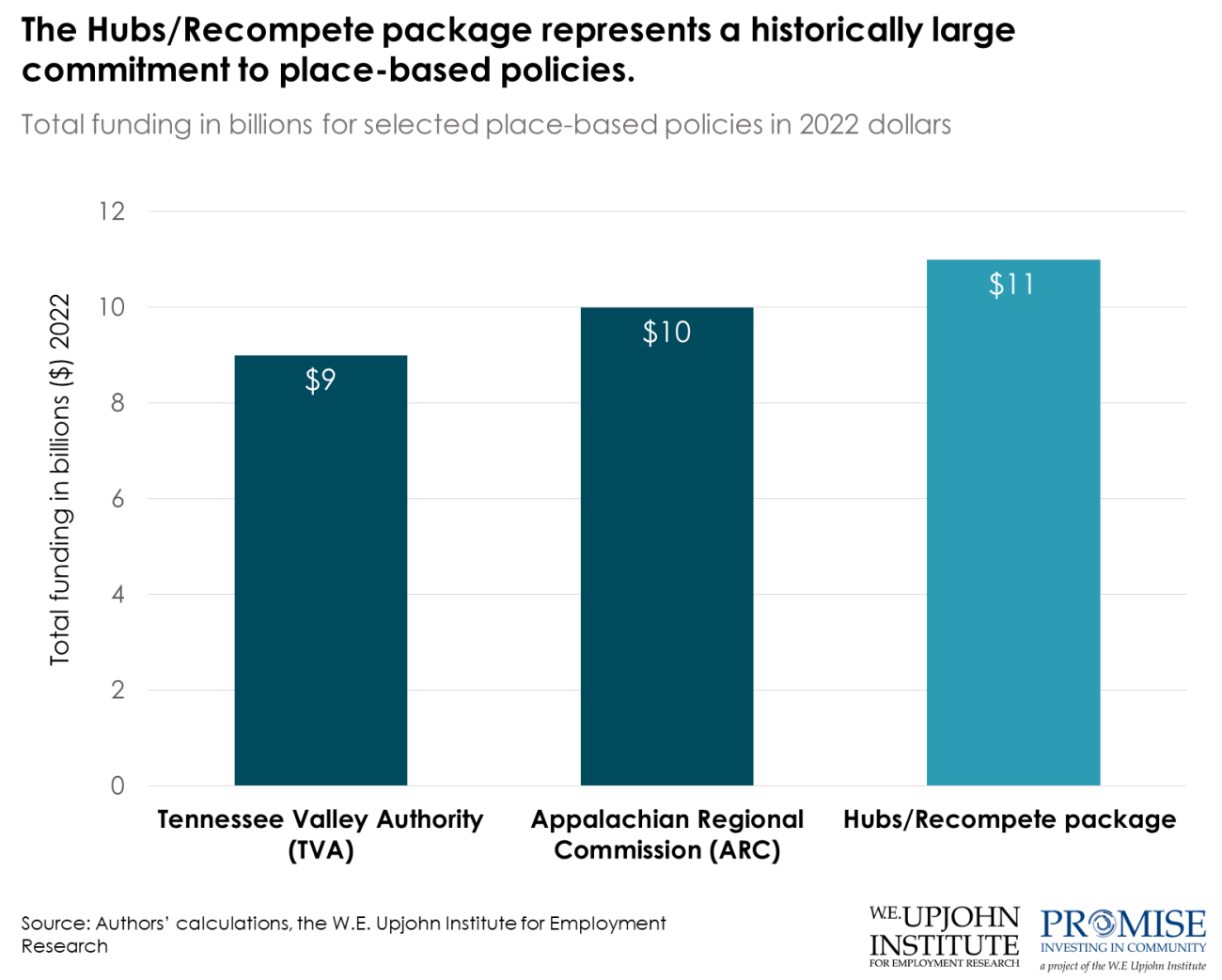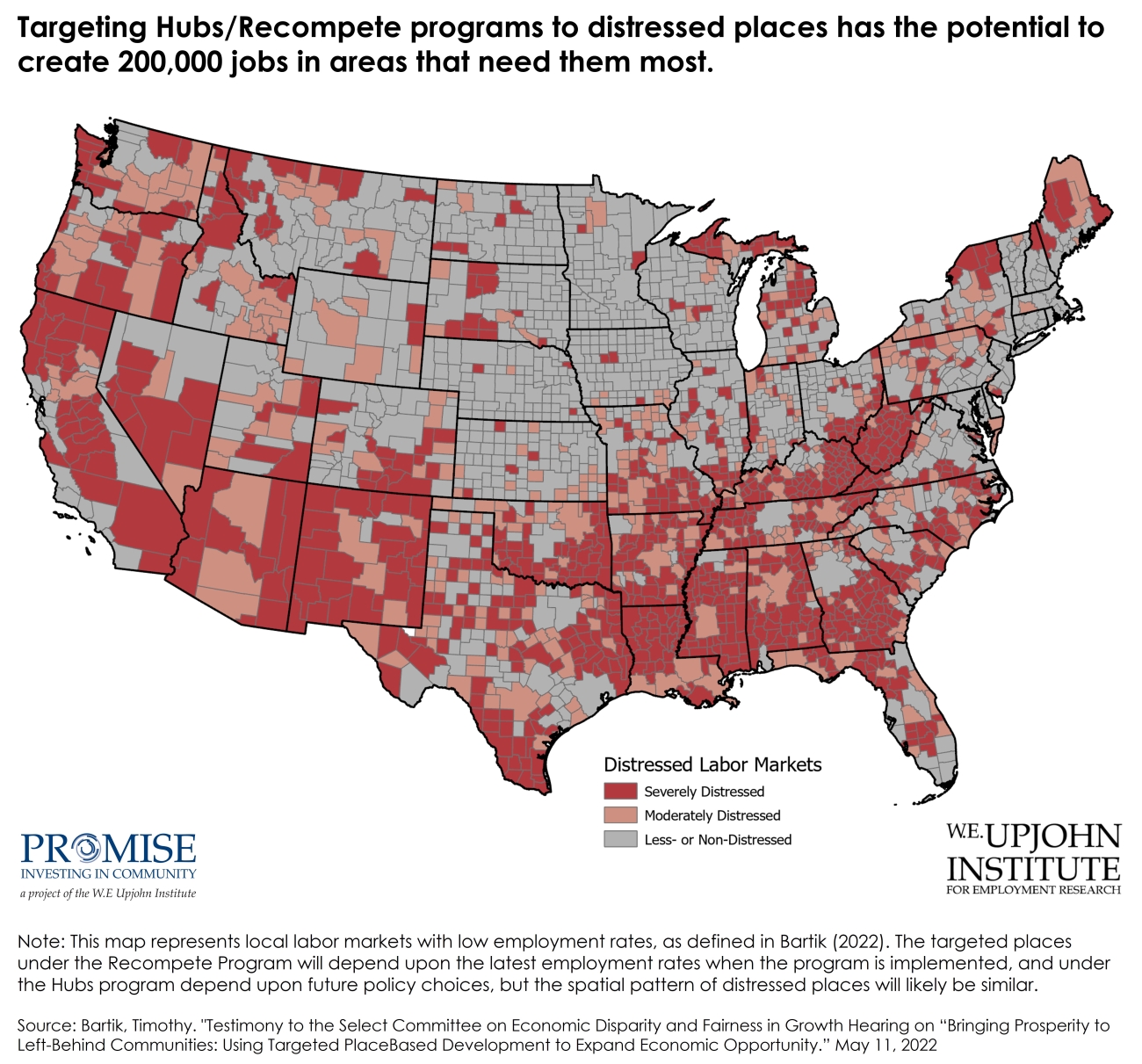By Timothy Bartik, Brian Asquith and Kathleen Bolter
August 8, 2022
The congressionally passed CHIPS and Science Act (CSA), to be signed into law by President Biden on August 9, has received the most publicity for its approximately $50 billion in subsidies for American semiconductor manufacturing. Yet the bill is also noteworthy for including what is potentially the most significant place-based policy funding in U.S. history.
Although CSA’s investment in place-based policies arguably falls short of fully meeting the needs of distressed places, CSA contains two significant place-based initiatives:
- $10 billion that would cover five years of costs to help create 20 “Regional Technology Hubs,” which would seek to broaden U.S. technology centers beyond the current dominant regions, such as Silicon Valley, Seattle, Boston and San Diego.
- $1 billion for five years of costs of a pilot version of the Recompete Act, which will assist 10 distressed communities with significantly below average employment-to-population ratios.
The Hubs program is a descendent of two proposals: one originally developed by Mark Muro and Jacob Whiton of the Brookings Institution, and Rob Atkinson of the Information Technology and Innovation Foundation; and another by Simon Johnson and Jonathan Gruber at MIT.
The Recompete program is a pilot version of a proposal introduced by Congressman Derek Kilmer, which in turn was based on a proposal developed by Tim Bartik of the Upjohn Institute, one of the authors of this article.
For both the Hubs and Recompete programs, the funding can be used flexibly for a wide variety of infrastructure and services to encourage local economic development. These services would include workforce development programs, entrepreneurial development programs and any physical infrastructure needed to support private-sector job creation. The distinction between the two programs is that the Hubs program is oriented toward technology development in places that potentially could be regional technology centers, whereas the Recompete program promotes economic development in a wider variety of industries — but only in places that are economically distressed. The Hubs program also allocates funding specifically for various types of technology development.
Compared to the two largest, long-established placed-based policies in the United States, the Hubs/Recompete package of $11 billion during a five-year period represents a major commitment. The Tennessee Valley Authority (TVA) program, begun during the 1930s and continuing to the present, at its peak in the 1950s spent about $9 billion (in 2022 dollars) over a five-year period, for a region that at that time had a population of around 5 million. The Appalachian Regional Commission (ARC), begun in 1965 and continuing to today, at its peak in the 1970s spent about $10 billion (2022 dollars) over a five-year period, for a region that at that time had a population of around 20 million.

Based on the TVA/ARC experience, the Hubs/Recompete package is big enough to provide reasonable levels of economic development funding in places where the total population could be as high as 20 million people. Prior studies suggest that well-run economic development programs that provide services and infrastructure for business development can create jobs at a cost per job of around $55,000. At that cost per job, the $11 billion in Hubs/Recompete funding could potentially create around 200,000 jobs in targeted places—but only if the funds are spent efficiently.
However, the Hubs/Recompete package falls far short of meeting the full need for place-based policies. For example, the original Recompete Act introduced by Congressman Kilmer provided $175 billion in funding over 10 years for distressed places with low employment-to-population ratios, with eligible distressed places having a total population of 83 million people. As another example, estimates suggest that even when the U.S. unemployment rate is low, as it is today, distressed local labor markets and neighborhoods probably need to add at least 11 million jobs to reach nearly full employment.

Despite only scratching the surface of needed funding, the Hubs/Recompete package represents a major opportunity to demonstrate the potential for higher-level governments to broaden economic prosperity to residents of “left behind” places.
To fully realize this potential, two things should happen:
- The Hubs/Recompete package must be implemented so as to ensure that a significant number of jobs go to residents who are unemployed or underemployed;
- The program must be evaluated rigorously so that we know whether it worked well enough to be worth this $11 billion investment.
The Hubs program is not tightly targeted to distressed places, although one-third of the selected Hubs are supposed to be in rural communities or smaller metro areas, many of which are economically distressed. In addition, the selection criterion for Hub designation mentions the need to “create[e] new economic opportunities for economically disadvantaged and underrepresented populations.” This will happen to a greater extent if a Hub is in a local labor market that has a low employment-to-population ratio. These greater opportunities will also happen to a greater extent if the proposed Hub plan includes, as part of its infrastructure and workforce development components, extensive plans to help disadvantaged groups get training, childcare support and better transportation access to some of the new entry-level jobs provided by the Hubs. Not all Hub jobs will require four-year college degrees, and a successful Hub proposal should outline in some detail how the Hub can serve the job needs of a wide variety of area residents.
Therefore, the selection system for Hub designation should prioritize areas that are more economically distressed and that devote more resources to increasing job access for disadvantaged populations. To make this concrete: If a booming economy such as Minneapolis-St. Paul is awarded a Hub, the proposal should be required to identify how the proposed Hub will make some significant proportion of its jobs accessible to disadvantaged populations in the Twin Cities area. In addition, proposals from more distressed potential Hubs such as Detroit should be prioritized.
We would also argue, in the spirit of the TVA, that Hubs should not be limited to places that already have most of the infrastructure necessary to spur greater local innovation. Sometimes the greatest returns can come when the government helps local communities build institutions from scratch.
For evaluation purposes, the Hubs and Recompete program language in CSA requires grant recipients to report on activities and achievements. But also needed is adequate funding for a national evaluation of the overall success of these programs. This evaluation will be facilitated if the Economic Development Administration in the Department of Commerce, which will administer the Hubs and Recompete programs, uses a quantitative scoring system to select the approximately 20 Hubs from among many more applicants, and also to select the 10 Recompete pilot communities among many more applicants. By a quantitative scoring system, we mean that program administrators should award points based on the quality of various components of submitted proposals, and award the Hub designation or Recompete pilot community designation to the proposals that exceed some score cutoff. The national evaluation can then look at employment and earnings trends in places that are grant recipients and only narrowly made the score cutoff for funding, compared to places that were not funded but were just below the needed score cutoff.
With this national evaluation, using reasonably rigorous evaluation methods, the highest scoring proposals still get funded, but we have a reasonable comparison group for measuring the effects of the program on employment, employment-to-population ratios, wage rates, and earnings per capita, both overall and for various population groups. If the Hubs and Recompete programs are to lead to a firmer federal commitment to place-based policies, rigorous evaluation methods must be used to convince skeptics that place-based policies can have benefits exceeding costs, and that these benefits are broadly shared.
Overall, the CSA provides a unique occasion for experimentation at the local level. Its flexibility allows policies to be customized to the needs of specific communities and, if done right, evaluated for return on investment. The Hubs and Recompete programs represent an excellent avenue for evidence-based policymaking that could be applied to a wide variety of places. The next political issue is whether the federal appropriations process will fully fund these programs at the $11 billion level. We hope policymakers get the opportunity to try new programs, learn from them, and invest in what works to create more good jobs for all their residents.



